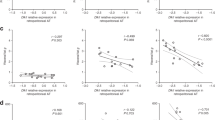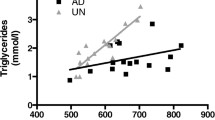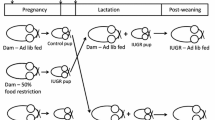Abstract
As enhanced adipogenesis contributes to programmed obesity, adipogenic and lipogenic signaling pathways in intrauterine growth restricted (IUGR) offspring were examined. From 10 days to term gestation, rats received ad libitum food (control) or were 50% food-restricted (IUGR). Pups were nursed and weaned to ad libitum diet. mRNA and protein levels of adipogenic transcription factors and lipid enzymes (1 day and 9 month) and adipocyte cell size (3 weeks and 9 months) were determined. Oneday-old IUGR males showed upregulation of peroxisome proliferator-activated receptor (PPARγ2), including upstream factors regulating PPARγ, and RXRα, with which PPARγ heterodimerizes. Intracellular lipolytic enzyme (hormone-sensitive lipase) was downregulated. Nine-month-old IUGR males showed upregulation of adipogenic and lipogenic (SREBP1c) transcription factors with upregulation of enzymes facilitating fatty acid uptake (lipoprotein lipase) and synthesis (fatty acid synthase), leading to hypertrophic adipocytes. Paradoxical upregulation of adipogenesis signaling cascade prior to the development of obesity in IUGR males suggests early changes in signaling mechanisms.
Similar content being viewed by others
References
Ogden CL, Yanovski SZ, Carroll MD, Flegal KM The epidemiology of obesity. Gastroenterology. 2007;132:2087–2102.
Plagemann A., Harder T. The changing face and implications of childhood obesity. N Engl J Med. 2004;350:2414–2416.
Reilly MP, Rader DJ The metabolic syndrome: more than the sum of its parts? Circulation. 2003;108:1546–1551.
Spiegelman BM, Flier JS Adipogenesis and obesity: rounding out the big picture. Cell. 1996;87:377–389.
Ailhaud G., Grimaldi P., Negrel R. Cellular and molecular aspects of adipose tissue development. Annu Rev Nutr. 1992; 12:207–233.
Hausman DB, DiGirolamo M., Bartness TJ, Hausman GJ, Martin RJ The biology of white adipocyte proliferation. Obes Rev. 2001;2:239–254.
Gregoire FM, Smas CM, Sul HS Understanding adipocyte differentiation. Physiol Rev. 1998;78:783–809.
Morrison RF, Farmer SR Insights into the transcriptional control of adipocyte differentiation. J Cell Biochem. 1999; 32–33:59–67.
Rosen ED, Walkey CJ, Puigserver P., Spiegelman BM Transcriptional regulation of adipogenesis. Genes Dev. 2000; 14:1293–1307.
Darlington GJ, Ross SE, MacDougald OA The role of C/EBP genes in adipocyte differentiation. J Biol Chem. 1998;273:30057–30060.
Rosen ED, Spiegelman BM PPARgamma: a nuclear regulator of metabolism, differentiation, and cell growth. J Biol Chem. 2001;276:37731–37734.
Lane MD, Lin FT, MacDougald OA, Vasseur-Cognet M. Control of adipocyte differentiation by CCAAT/enhancer binding protein alpha (C/EBP alpha). Int J Obes Relat Metab Disord. 1996;20(suppl 3):S91–S96.
Rosen ED, Hsu CH, Wang X., et al. C/EBPalpha induces adipogenesis through PPARgamma: a unified pathway. Genes Dev. 2002;16:22–26.
Fajas L., Schoonjans K., Gelman L., et al. Regulation of peroxisome proliferator-activated receptor gamma expression by adipocyte differentiation and determination factor 1/sterol regulatory element binding protein 1: implications for adipocyte differentiation and metabolism. Mol Cell Biol. 1999;19:5495–5503.
Kim JB, Spiegelman BM ADD1/SREBP1 promotes adipocyte differentiation and gene expression linked to fatty acid metabolism. Genes Dev. 1996;10:1096–1107.
Maggio CA, Greenwood MR Adipose tissue lipoprotein lipase (LPL) and triglyceride uptake in zucker rats. Physiol Behav. 1982;29:1147–1152.
Berndt J., Kovacs P., Ruschke K., et al. Fatty acid synthase gene expression in human adipose tissue: association with obesity and type 2 diabetes. Diabetologia. 2007;50:1472–1480.
Mobbs CV, Makimura H. Block the FAS, lose the fat. Nat Med. 2002;8:335–336.
Holm C., Osterlund T., Laurell H., Contreras JA Molecular mechanisms regulating hormone-sensitive lipase and lipolysis. Annu Rev Nutr. 2000;20:365–393.
Barker M., Robinson S., Osmond C., Barker DJ Birth weight and body fat distribution in adolescent girls. Arch Dis Child. 1997;77:381–383.
Ravelli GP, Stein ZA, Susser MW Obesity in young men after famine exposure in utero and early infancy. N Engl J Med. 1976;295:349–353.
Levin BE, Govek E. Gestational obesity accentuates obesity in obesity-prone progeny. Am JPhysiol. 1998;275:R1374–R1379.
Desai M., Gayle D., Babu J., Ross MG Programmed obesity in intrauterine growth-restricted newborns: modulation by newborn nutrition. Am J Physiol Regul Integr Comp Physiol. 2005;288:R91–R96.
Desai M., Gayle D., Babu J., Ross MG The timing of nutrient restriction during rat pregnancy/lactation alters metabolic syndrome phenotype. Am J Obstet Gynecol. 2007;196:555.e1–e7.
Desai M., Gayle D., Gaung H., Ross MG Programmed hyperphagia due to reduced anorexigenic mechanisms in intrauterine growth-restricted offspring. Reprod Sci. 2007;14:329–337.
Spiegelman BM, Choy L., Hotamisligil GS, Graves RA, Tontonoz P. Regulation of adipocyte gene expression in differentiation and syndromes of obesity/diabetes. J Biol Chem. 1993;268:6823–2686.
De Rijk E. Pregnancy dating in the rat: placental morphology and maternal blood parameters. Toxicol Pathol. 2002;30:271–282.
Park CS Role of compensatory mammary growth in epigenetic control of gene expression. FASEB J.2005;19:1586–1591.
McGuire MK, Littleton AW, Schulze KJ, Rasmussen KM Pre- and postweaning food restrictions interact to determine reproductive success and milk volume in rats. J Nutr. 1995; 125:2400–2406.
Cooke PS, Naaz A. Role of estrogens in adipocyte development and function. Exp Biol Med. 2004;229:127–135.
Hotta K., Gustafson TA, Yoshioka S., Ortmeyer HK, Bodkin NL, Hansen BC Relationships of PPARgamma and PPARgamma2 mRNA levels to obesity, diabetes and hyperinsulinaemia in rhesus monkeys. Int J Obes Relat Metab Disord. 1998;22:1000–1010.
Kubota N., Terauchi Y, Miki H., et al. PPAR gamma mediates high fat diet-induced adipocyte hypertrophy and insulin resistance. Mol Cell. 1999;4:597–609.
Llado I., Pons A., Palou A. Effects of fasting on lipoprotein lipase activity in different depots of white and brown adipose tissues in diet-induced overweight rats. JNutr Biochem. 1999;10:609–614.
Arner P., Bolinder J., Engfeldt P., Ostman J. The antilipolytic effect of insulin in human adipose tissue in obesity, diabetes mellitus, hyperinsulinemia, and starvation. Metabolism. 1981;30:753–760.
Large V., Reynisdottir S., Langin D., et al. Decreased expression and function of adipocyte hormone-sensitive lipase in subcutaneous fat cells of obese subjects. J Lipid Res. 1999;40:2059–2066.
Boizard M., Le Liepvre X., Lemarchand P., Foufelle F., Ferre P., Dugail I. Obesity-related overexpression of fatty-acid synthase gene in adipose tissue involves sterol regulatory element-binding protein transcription factors. J Biol Chem. 1998;273:29164–29171.
Bergo M., Wu G., Ruge T., Olivecrona T. Down-regulation of adipose tissue lipoprotein lipase during fasting requires that a gene, separate from the lipase gene, is switched on. J Biol Chem. 2002;277:11927–11932.
Samra JS, Clark ML, Humphreys SM, Macdonald IA, Frayn KN Regulation of lipid metabolism in adipose tissue during early starvation. Am J Physiol. 1996;271:E541–E546.
Sztalryd C., Kraemer FB Regulation of hormone-sensitive lipase during fasting. Am J Physiol. 1994;266:E179–E185.
Berger JP, Akiyama TE, Meinke PT PPARs: therapeutic targets for metabolic disease. Trends Pharmacol Sci. 2005;26:244–251.
Kopecky J., Flachs P., Bardova K., Brauner P., Prazak T., Sponarova J. Modulation of lipid metabolism by energy status of adipocytes: implications for insulin sensitivity. Ann NY Acad Sci. 2002;967:88–101.
Jocken JW, Langin D., Smit E., et al. Adipose triglyceride lipase and hormone-sensitive lipase protein expression is decreased in the obese insulin-resistant state. J Clin Endocrinol Metab. 2007;92:2292–2299.
Vickers MH, Gluckman PD, Coveny AH, et al. Neonatal leptin treatment reverses developmental programming. Endocrinology. 2005;146:4211–4216.
Xue F., Willett WC, Rosner BA, Forman MR, Michels KB Parental characteristics as predictors of birthweight. Hum Reprod. 2008;23:168–177.
Gardner DS, Buttery PJ, Daniel Z., Symonds ME Factors affecting birth weight in sheep: maternal environment. Reproduction. 2007;133:297–307.
Yakubu DP, Mostyn A., Wilson V., et al. Different effects of maternal parity, cold exposure and nutrient restriction in late pregnancy on the abundance of mitochondrial proteins in the kidney, liver and lung of postnatal sheep. Reproduction. 2007; 133:1241–1252.
Author information
Authors and Affiliations
Corresponding author
Additional information
This work was supported by the National Institutes of Health K01 DK 063994 and the March of Dimes.
Rights and permissions
About this article
Cite this article
Desai, M., Han, G., Ferelli, M. et al. Programmed Upregulation of Adipogenic Transcription Factors in Intrauterine Growth-Restricted Offspring. Reprod. Sci. 15, 785–796 (2008). https://doi.org/10.1177/1933719108318597
Published:
Issue Date:
DOI: https://doi.org/10.1177/1933719108318597




